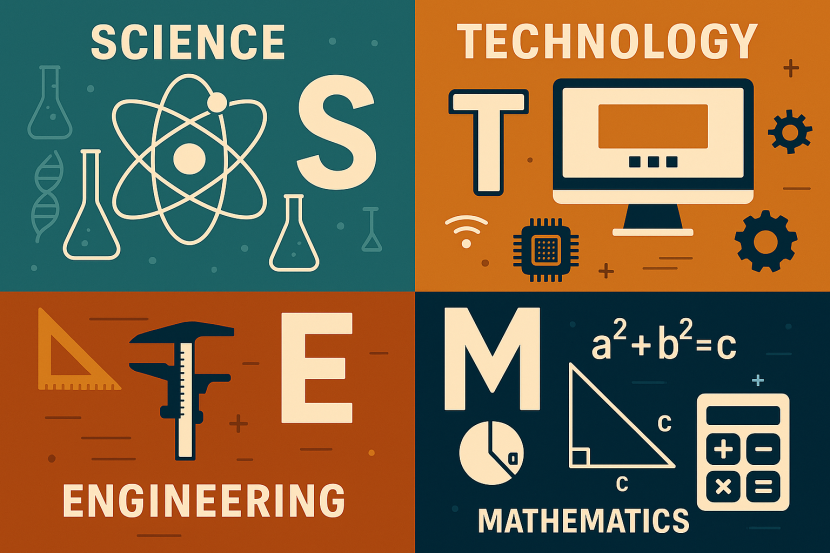In an era driven by technology and innovation, one would expect Science, Technology, Engineering, and Mathematics (STEM) to be among the most popular academic fields. Yet, a growing number of students are turning away from these subjects, despite the promising career prospects they offer. This declining interest has raised concerns among educators, policymakers, and industry leaders alike. What is causing students to lose enthusiasm for STEM? Is the issue rooted in the education system, societal influences, or changing career aspirations? In this blog, we explore the underlying reasons behind this shift and discuss potential strategies to make STEM more engaging and accessible for all learners.
The Complexity and Rigid Structure of STEM Education
STEM subjects are often perceived as inherently difficult, filled with abstract theories, complex calculations, and rigid rules. For many students, especially those without strong foundational skills, this complexity becomes a barrier rather than a challenge. Unlike subjects that allow for open interpretation or creativity, STEM education typically emphasizes accuracy, formulaic problem-solving, and one “right” answer.
This rigid structure can be discouraging for students who thrive in more exploratory or expressive learning environments. Instead of nurturing curiosity, it can create a fear of failure and a belief that only the “naturally gifted” can succeed in STEM. As a result, many students disengage early on, believing that STEM is not for them—when in reality, the issue often lies in how the material is delivered, not the students’ abilities.
Lack of Real-World Connection
One of the biggest reasons students lose interest in STEM is the difficulty in relating these subjects to their everyday lives. While formulas, theories, and technical concepts are essential, they often feel disconnected from real-world applications when taught in isolation. When students don’t see how math applies to budgeting, how physics explains the world around them, or how coding powers the apps they use daily, STEM can seem dull, abstract, and irrelevant.
This disconnect reduces motivation and curiosity—two key ingredients for learning. Without context, even the most brilliant concepts can feel meaningless. To re-engage students, it’s essential to show how STEM shapes industries, solves real problems, and plays a vital role in everything from medicine to environmental sustainability to space exploration.
Inadequate Teaching Methods
Traditional teaching methods often fail to spark interest in STEM subjects. Lecture-based instruction, heavy reliance on textbooks, and rote memorization are still common practices in many classrooms. These methods tend to prioritize information delivery over active engagement, leaving little room for hands-on experiments, creative problem-solving, or student-driven inquiry.
As a result, STEM education can feel monotonous and disconnected from real intellectual discovery. Students are rarely encouraged to ask questions, explore ideas independently, or collaborate on innovative projects—skills that are fundamental to success in science and technology careers. This lack of dynamic and interactive teaching not only stifles curiosity but also reinforces the belief that STEM is rigid and difficult, pushing many students to opt for more stimulating or accessible fields.
Stereotypes and Gender Gaps
Despite growing awareness, STEM fields continue to be influenced by longstanding stereotypes—particularly the idea that they are more suited to males than females. These gender biases are often subtly reinforced through media, classroom dynamics, and even family expectations. Girls and underrepresented minorities may receive less encouragement to pursue STEM subjects or may feel isolated in classrooms and labs where they are in the minority.
This lack of representation can lead to lower confidence, reduced participation, and a diminished sense of belonging. Even when girls perform equally well or better in STEM subjects, societal messages often steer them toward careers perceived as more “feminine” or less technical. Additionally, the absence of diverse role models in STEM professions makes it harder for students to envision a future for themselves in these fields.
Addressing these stereotypes and creating inclusive, supportive learning environments is crucial to ensuring that all students—regardless of gender or background—feel empowered to explore and succeed in STEM.
Early Academic Pressure and Fear of Failure
From a young age, students are introduced to STEM subjects with high expectations and often intense pressure to perform. Mathematics and science, in particular, are seen as markers of academic excellence, leading to an environment where mistakes are feared rather than embraced as part of the learning process. This pressure can result in anxiety, low self-esteem, and a growing dislike for the subjects.
Moreover, STEM education is frequently associated with high-stakes exams and rigid grading systems, which leave little room for experimentation or learning through trial and error. Students who struggle even slightly may be labeled as “not good at math” or “not cut out for science,” internalizing a fixed mindset that discourages further effort. Instead of viewing challenges as opportunities for growth, many begin to avoid STEM altogether, fearing failure and judgment.
To foster long-term interest, STEM education must become more supportive, growth-oriented, and focused on learning rather than just performance.
Limited Exposure to STEM Careers
Many students are unaware of the wide range of dynamic, high-impact careers that STEM fields offer. Their understanding is often limited to a narrow set of professions—like doctors, engineers, or scientists—without realizing the diversity within those paths or the emerging opportunities in fields like data science, biotechnology, environmental engineering, robotics, and AI.
This lack of exposure stems from insufficient career guidance, limited industry interaction, and the absence of role models from STEM backgrounds in their communities or schools. When students can’t see real-world examples of people thriving in these fields—especially people who look like them—they struggle to envision themselves in similar roles.
Bridging this gap requires proactive efforts, such as inviting STEM professionals to speak in schools, organizing career exploration programs, and integrating real-world STEM applications into the curriculum. Helping students connect their interests to tangible future opportunities can make STEM not only relevant but also exciting.
The Rise of Non-STEM Alternatives
In today’s digital and creative economy, students are increasingly drawn to non-STEM fields that offer greater flexibility, personal expression, and cultural relevance. Careers in digital marketing, content creation, graphic design, entrepreneurship, and the performing arts have gained popularity, especially among younger generations who value autonomy and creativity in their work.
Many of these career paths appear more accessible and less intimidating than traditional STEM roles, which are often seen as requiring years of intense study and specialized skills. Additionally, the rapid success of influencers, tech entrepreneurs, and creatives on social media platforms presents a compelling alternative to the structured and often rigid nature of STEM education.
This shift doesn’t necessarily mean students lack capability in STEM—it often reflects a desire for work that feels more immediately rewarding or aligned with their passions. To stay competitive, STEM education must adapt by showing how innovation and creativity are deeply embedded in science and technology as well.
What Can Be Done?
To reignite student interest in STEM, there needs to be a fundamental shift in how these subjects are taught and perceived. One of the most effective approaches is to move beyond textbook-based instruction and embrace hands-on, project-driven learning that connects theory to real-life applications. When students engage in experiments, build models, or solve real-world problems, the abstract nature of STEM becomes more tangible and relevant.
Integrating creativity into STEM education—through the STEAM (Science, Technology, Engineering, Arts, and Mathematics) approach—can also help students see that innovation often requires both technical skills and imagination. Encouraging a growth mindset is equally important; students need to feel that making mistakes is a normal and valuable part of the learning process, not a sign of failure.
Representation matters, too. By highlighting diverse role models in STEM fields, educators can help students envision themselves in those careers, regardless of their gender, ethnicity, or background. Improved career guidance and mentorship can further open doors, helping students explore the wide range of exciting opportunities available in modern STEM fields.
Finally, modernizing teaching methods to include interactive, collaborative, and inquiry-based learning can go a long way in making STEM subjects more engaging and accessible. When students feel supported, inspired, and connected to the material, their interest in STEM can thrive.
Final Thoughts
The declining interest in STEM subjects among students is not simply a matter of preference—it’s a reflection of deeper issues within the education system, societal expectations, and how we present science and technology to young minds. STEM fields are the foundation of innovation, yet they are often taught in ways that feel disconnected, intimidating, or exclusive. By making STEM education more inclusive, engaging, and relevant to students’ lives and futures, we can break down the barriers that discourage exploration and curiosity. The goal isn’t just to produce more scientists or engineers, but to empower all students with the confidence and skills to understand and shape the world around them.




